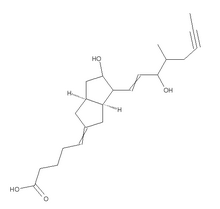Iloprost
Iloprost, an inhalation solution, is sold under the name Ventavis® and is used to treat pulmonary arterial hypertension (PAH). It was developed by the pharmaceutical company Schering AG and is marketed by by Schering AG in Europe and Cotherix, Inc. in the USA. more...
Clinical pharmacology
Iloprost is a synthetic analogue of prostacyclin PGI2. Iloprost dilates systemic and pulmonary arterial vascular beds. It also affects platelet aggregation but the relevance of this effect to the treatment of pulmonary hypertension is unknown. The two diastereoisomers of iloprost differ in their potency in dilating blood vessels, with the 4S isomer substantially more potent than the 4R isomer.
Dosage and administration
In the US, iloprost is intended to be inhaled using the I-Neb® AAD® or Prodose® AAD® Systems, pulmonary drug delivery devices.
The approved dosing regimen for ilprost is 6 to 9 times daily (no more than every 2 hours) during waking hours, according to individual need and tolerability. The significant clinical effects observed in the pivotal study of patients with PAH were achieved with a median dose of 30 mcg per day (range: 12.5 to 45 mcg delivered at the mouthpiece), corresponding to 6 daily inhalations of 5 mcg. The majority of patients (> 80%) in the pivotal study used this median dose or a higher dose with an excellent treatment compliance after 12 weeks.
The first inhaled dose of iloprost should be 2.5 mcg (as delivered at the mouthpiece). If this dose is well tolerated, dosing should be increased to 5 mcg and maintained at that dose. Any patient who cannot tolerate the 5 mcg dose should be maintained at 2.5 mcg.
Each inhalation treatment requires one entire single-use ampule. Each single-use ampule delivers 20 mcg/2 mL to the medication chamber of either the I-Neb® AAD® or Prodose® AAD® System, and delivers a nominal dose of either 2.5 mcg or 5.0 mcg to the mouthpiece. After each inhalation session, any solution remaining in the medication chamber should be discarded. Use of the remaining solution, even if the reservoir is “topped off” with fresh medication, will result in unpredictable dosing. Patients should follow the manufacturer’s instructions for cleaning the I-Neb® AAD® or Prodose® AAD® System components after each dose administration.
Complete information regarding use of iloprost in specific populations (e.g. nursing mothers, pediatrics, patients with hepatic or renal impairment), drug interactions, and overdosage can be found in full prescribing information.
Important Safety Information
Contraindications:
- There are no known contraindications.
Common side effects:
- In clinical studies, common adverse reactions due to inhaled iloprost included: vasodilation (flushing, 27%), cough (39%), headache (30%), flu syndrome (14%), nausea (13%), trismus (12%), hypotension (11%), insomnia (8%), and syncope (8%); other serious adverse events reported with the use of Ventavis included congestive heart failure, chest pain, supraventricular tachycardia, dyspnea, peripheral edema, and kidney failure.
Serious adverse events reported with the use of inhaled iloprost include congestive heart failure, chest pain, supraventricular tachycardia, dyspnea, peripheral edema, and kidney failure.
Read more at Wikipedia.org



